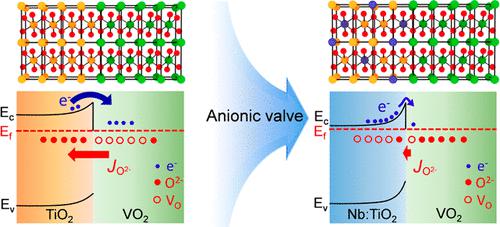当前位置:
X-MOL 学术
›
Nano Lett.
›
论文详情
Our official English website, www.x-mol.net, welcomes your feedback! (Note: you will need to create a separate account there.)
Anionic Flow Valve Across Oxide Heterointerfaces by Remote Electron Doping
Nano Letters ( IF 10.8 ) Pub Date : 2022-11-17 , DOI: 10.1021/acs.nanolett.2c02736 Yunkyu Park 1 , Hyeji Sim 1 , Kyung-Yeon Doh 1 , Minguk Jo 1 , Donghwa Lee 1 , Si-Young Choi 1 , Junwoo Son 1
Nano Letters ( IF 10.8 ) Pub Date : 2022-11-17 , DOI: 10.1021/acs.nanolett.2c02736 Yunkyu Park 1 , Hyeji Sim 1 , Kyung-Yeon Doh 1 , Minguk Jo 1 , Donghwa Lee 1 , Si-Young Choi 1 , Junwoo Son 1
Affiliation

|
As an analogue of charged electron flows, the ionic flow could be controlled by the electronic band alignment due to the ambipolar nature of diffusion in the ionic crystal. Here, we demonstrate the active control of the anionic diffusion across heterointerfaces through remote electron doping in the capping layers. In contrast to the spontaneous ionic flux from the underlying VO2 layers to the undoped TiO2 capping layers, the activated Nb dopants in the TiO2 capping layers substantially restrict the ionic flux, despite identical growth conditions. The increase of Fermi level by Nb donors in TiO2 prevents electron flux from being generated across the interfaces by the heightening of a Schottky barrier; this electron shortage generates a kinetic close valve for the flow of negatively charged oxygen ions. Thus, these results demonstrate the importance of electron supply on charged ionic flow, thereby suggesting an unprecedented strategy for ionic-defect-induced emergent properties at interfaces.
中文翻译:

通过远程电子掺杂跨氧化物异质界面的阴离子流阀
作为带电电子流的模拟,由于离子晶体中扩散的双极性质,离子流可以通过电子能带排列来控制。在这里,我们展示了通过覆盖层中的远程电子掺杂对跨异质界面的阴离子扩散的主动控制。与从下面的 VO 2层到未掺杂的 TiO 2覆盖层的自发离子通量相反,尽管生长条件相同,但 TiO 2 覆盖层中活化的 Nb 掺杂剂显着限制了离子通量。TiO 2中Nb供体增加费米能级通过提高肖特基势垒来防止跨界面产生电子通量;这种电子短缺为带负电的氧离子的流动产生了一个动力学关闭阀。因此,这些结果证明了电子供应对带电离子流的重要性,从而提出了一种前所未有的界面处离子缺陷诱导涌现特性的策略。
更新日期:2022-11-17
中文翻译:

通过远程电子掺杂跨氧化物异质界面的阴离子流阀
作为带电电子流的模拟,由于离子晶体中扩散的双极性质,离子流可以通过电子能带排列来控制。在这里,我们展示了通过覆盖层中的远程电子掺杂对跨异质界面的阴离子扩散的主动控制。与从下面的 VO 2层到未掺杂的 TiO 2覆盖层的自发离子通量相反,尽管生长条件相同,但 TiO 2 覆盖层中活化的 Nb 掺杂剂显着限制了离子通量。TiO 2中Nb供体增加费米能级通过提高肖特基势垒来防止跨界面产生电子通量;这种电子短缺为带负电的氧离子的流动产生了一个动力学关闭阀。因此,这些结果证明了电子供应对带电离子流的重要性,从而提出了一种前所未有的界面处离子缺陷诱导涌现特性的策略。



























 京公网安备 11010802027423号
京公网安备 11010802027423号